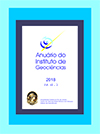Geology, Petrology and Magmatic Evolution of the Felsic Alkaline Rocks of the Vitória Island, São Paulo State, Brazil
DOI:
https://doi.org/10.11137/2018_3_125_136Keywords:
Vitória Island, Nepheline Syenite, Syenite, Fractional CrystallizationAbstract
This paper presents geological, petrographic, geochemical characteristics and radiometric ages for the felsic alkaline rocks of the Vitória Island Intrusive Complex, São Paulo State, Brazil, and discusses its geochemical evolutionary processes. This intrusive body is about 3 km in diameter and the emerged island areas correspond to its northeastern border. The main intrusion is constituted by nepheline syenite at the central zone, nepheline-bearing syenite at the outer zone, syenite at the border, and quartz syenite at the contact zone with alkali feldspar represented by orthoclase. Clinopyroxene vary from hedenbergite, soda-augite to aegirine-augite, and some crystals have resorption shape and amphibole reaction rim. They are intruded by phonolite, trachyte and lamprophyre dykes. Based on the intrusion relation, the dykes are subdivided into two generations: the first one encompass a radial system and the second a parallel system with NE-SW orientation and sinistral displacement. The alkaline rocks vary from silica undersaturated to oversaturated, show peralkaline to peraluminous compositions and belong to the potassic series. The K-Ar ages for amphibole of the nepheline-bearing syenite and syenite are 89.58 ± 3.18 Ma and 84.35 ± 3.92 Ma, respectively. The rocks are strongly fractionated with high differentiation index (DI) of 88.15 in average, indicating mafic minerals fractionation. K2O/ (K2O+Na2O) ratios are low, in average 0.51, in accordance to crystallization of pseudo leucite and potassic feldspar the last observed in thin sections.Downloads
Download data is not yet available.
Downloads
Published
2019-10-16
How to Cite
Motoki, A. (2019) “Geology, Petrology and Magmatic Evolution of the Felsic Alkaline Rocks of the Vitória Island, São Paulo State, Brazil”, Anuário do Instituto de Geociências. Rio de Janeiro, BR, 41(3), pp. 125–136. doi: 10.11137/2018_3_125_136.
Issue
Section
Article
License
This journal is licensed under a Creative Commons — Attribution 4.0 International — CC BY 4.0, which permits use, distribution and reproduction in any medium, provided the original work is properly cited.















